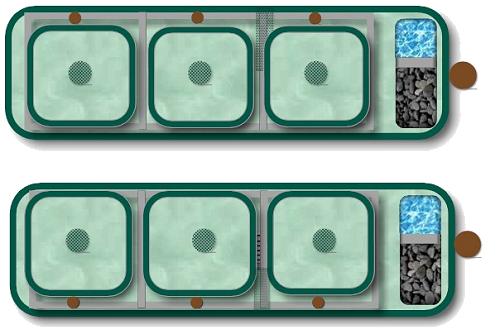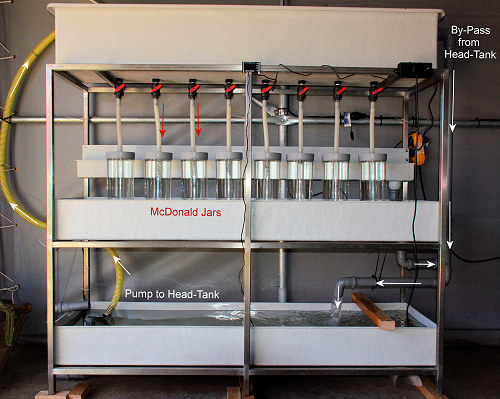Facility and equipment
Solar powered hatchery
The design of the hatchery is based on a design which has proven
it´s
 usefulness in fish larval rearing since more than 25 years. The
design was adapted to the specific needs under the conditions in
Malawi and the kind of species which will be reared in this
facility. The main elements of the hatchery are two large fiberglass
tanks with smaller tanks hanging inside of the big tanks (Figure 1).
The advantage of this compact design is obvious. The water
conditioning can be managed in the big tank (heating, aeration,
filtering, biofilter etc.) without having any mechanical impact on the larvae
inside the small tanks. On the other hand, the larvae inside of the
small tanks are practically swimming in about 12 cbm of water (the
volume of one tank unit). The
water in the big tank keeps the water temperature constant for all
smaller tanks, which is a huge advantage specifically if
research trials will be conducted in this facility. The hatchery is
based on a slab and housed in an industrial tent, which potentially
supports mobility.
usefulness in fish larval rearing since more than 25 years. The
design was adapted to the specific needs under the conditions in
Malawi and the kind of species which will be reared in this
facility. The main elements of the hatchery are two large fiberglass
tanks with smaller tanks hanging inside of the big tanks (Figure 1).
The advantage of this compact design is obvious. The water
conditioning can be managed in the big tank (heating, aeration,
filtering, biofilter etc.) without having any mechanical impact on the larvae
inside the small tanks. On the other hand, the larvae inside of the
small tanks are practically swimming in about 12 cbm of water (the
volume of one tank unit). The
water in the big tank keeps the water temperature constant for all
smaller tanks, which is a huge advantage specifically if
research trials will be conducted in this facility. The hatchery is
based on a slab and housed in an industrial tent, which potentially
supports mobility.

Fig.1: The hatcheries main elements are two identical units; each unit has a large fiberglass tank with three smaller tanks inside. Dimensions of the large tanks about 6.0 x 1.9 x 1.1 m (L x W x H). Dimensions of the smaller tanks are about 1.3 x 1.2 x 0.7 mm. Each unit has the same equipment and can be operated independently from each other, which allows e.g. rearing trials with different water temperatures.
The equipment used and the water flow is depicted and annotated in Figure 2. Each unit has a two-way circulation and can be operated in a batch mode, which means that a certain volume of water, based on the current water condition, is being exchanged or the system can be operated in a flow-through mode. The second option might be difficult to apply under the conditions in Malawi, since constant water pumping often fails because of frequent failure in grid electricity.

Fig. 2: The sketch depicts schematically the water circulation and the equipment installed in one tank unit. Water from the big tank is being pumped through a UV-unit, a filter unit outside which can be equipped with various filter cartouches and goes back to a coarse filter inside of the big tank. Attached to the coarse filter, a biofilters established which is fed with returning bypass water from the big tank. The other pump circulates the water from the big tank through the small tanks. Heaters are deployed in the water body of the big tanks. Significant aeration is being accomplished in the big tanks, inside of the small tanks only gentle aeration is being applied to keep larvae in the water column.
Ball valves at each water inlet into the smaller tanks allows to adjust the water current and, depending on the age, to adjust a more or less gentle current, drifting around the larvae so they cannot stuck in the corners. The tanks can be operated in a batch mode, i.e. a certain water volume can be exchanged on daily basis if necessary, or the tanks can be operated in a flow-through mode.
Egg incubation unit
In addition to the main rearing tanks, an egg incubation unit was
established inside next to the tanks, based on McDonald-type
hatching jars. Since the target species in the project are mainly
mouth breeders, the fertilized eggs can easily be retrieved from the females.
This facility along with the rearing tanks completes the full
control over the entire hatching and rearing process, facilitating
also the effort of selective breeding, in order to improve the
performance of the larvae and to control the results of
hybridization experiments (one attempt in the project to produce
all-male generations).

The picture shows the McDonald unit, installed in the hatchery. The system has a head and bottom tank, a tray for the jars and water is pumped continuously from the bottom tank to the head tank. One or two 300-Watt heater are installed in the bottom tank to achieve an appropriate temperature (optimal temperature is supposed to be 28°C for e.g. O. karongae). Water flow through the jars can individually be adjusted. The McDonald unit follows a very traditional method in Europe to breed eggs from salmon or trout. The breeding was accomplished in Zuger glasses or Zuger jars, the basic principle is the same as with the McDonald jars.
Solar power facility
Grid power in Malawi fails frequently, at present only an average of 6-8 hours of power from the public grid per day can be expected. Since such a hatchery set-up needs constant power supply in order to run pumps, aeration, illumination and heaters without a break, a solar power unit was attached to the hatchery. Gensets as continues provider of power are not an option, since fuel is very expensive in Malawi.
The solar power unit was designed as an island
solution and provides sufficient power for the equipment in the
hatchery 24h/7days a week. The solar facility provides about 1.7kW which is sufficient to run the most important equipment
without a break. The solar power can automatically switch to grid
power when available. A diesel genset which automatically
starts is being installed as an emergency back-up when both other
sources for electricity fail.

Schematic sketch of the solar power facility which provides permanent electricity for the hatchery operation. The system has 36 solar panels, each providing about 300 Watt. The battery block has 24 batteries with in total 48 Volt and 1270 Ah per battery. The facility is designed as an island solution; however, grid power can be used when available to increase the batteries life time. Additionally, a genset is attached as emergency back-up.
A GPRS modem was connected to the control unit, which allows the remote control of the operating data of the facility through the Internet which was very useful in the period beyond the first start-up of the system since this is a new technological approach in this environment.

The graph depicts a typical profile of power consumption, solar power harvest and battery charge status over 30 days. The solar panels are providing theoretically, exposed to full sunshine, 300 Watt per unit. There are two strings with 18 solar panels providing 5.400 Watt each. In total 10.800 Watt is the theoretical harvest from the panels; under practical conditions, however, it is mostly about 25% less what can be harvested, about 8000 Watt. Nevertheless, this is sufficient to provide non-stop power for pumps, aeration, light and heating in this type of hatchery set-up.